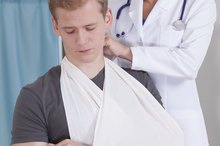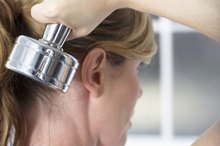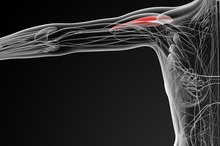Can I Lift Weights With a Glenoid Labrum Tear?
Injuries to the tissue surrounding the shoulder can be caused by severe trauma or repetitive motions. Examples of trauma include a direct blow to the shoulder, a fall onto the shoulder or a sudden pull during exercise. Athletes and weight lifters can experience tears in shoulder tissue due to repetitive shoulder motion.
If you are experiencing serious medical symptoms, seek emergency treatment immediately.
Glenoid Labrum Tear
The socket joint of the shoulder, called the glenoid, is surrounded by an auxiliary structure called the labrum 1. The shoulder itself is a ball and socket joint. Cartilage within the socket keeps movements smooth. Tears to this cartilage are called shoulder labral tears. Symptoms of a cartilage tear include:
- loss of strength
- instability in the shoulder
- night pain
- pain with daily activities
- a grinding or popping sensation,
- pain when lifting
- The socket joint of the shoulder, called the glenoid, is surrounded by an auxiliary structure called the labrum 1.
Treatment
Will a Torn Rotator Cuff Heal Without Surgery?
Learn More
Minor labrum tears usually take up to six weeks to heal. Treatment for these minor injuries begins with a program of resting, stretching and strengthening exercises, compression, and pain medications and anti-inflammatory medications to reduce pain and improve function of the shoulder. Rehabilitation exercises to strengthen the muscles also may be recommended. Patients with persistent symptoms or more serious tears may require surgery.
Read more about occupational therapy shoulder and rotator cuff exercises.
- Minor labrum tears usually take up to six weeks to heal.
- Treatment for these minor injuries begins with a program of resting, stretching and strengthening exercises, compression, and pain medications and anti-inflammatory medications to reduce pain and improve function of the shoulder.
Lifting Weights
This depends on the severity of your injury. The general answer is “no.” Until the final diagnosis is made by a doctor, it is ill-advised to continue your workout routine. Bench pressing and heavy weightlifting will aggravate the situation and possibly cause a more severe tear. Consult your doctor to find out what exercises are safe. If surgery is required, your arm will be immobilized in a sling for up to six weeks. A doctor may refer you to a physical therapist to work out a strength recovery program.
- This depends on the severity of your injury.
- Until the final diagnosis is made by a doctor, it is ill-advised to continue your workout routine.
Caution
Strengthening Exercises to Recover from a Fractured Humerus
Learn More
Most people can start light work which involves no pushing, lifting, pulling or carrying more than 1 or 2 lbs., eight weeks following the surgery. You might require up to six months of recovery before you begin moderate shoulder workouts, and it could take up to one year before you may do overhead lifts or heavy workouts with your shoulders. Do not try and rush your recovery process.
Read more about how long a pulled muscle takes to heal.
- Most people can start light work which involves no pushing, lifting, pulling or carrying more than 1 or 2 lbs., You might require up to six months of recovery before you begin moderate shoulder workouts, and it could take up to one year before you may do overhead lifts or heavy workouts with your shoulders.
Related Articles
References
- American Academy of Orthopaedic Surgeons; Shoulder Joint Tear (Glenoid Labrum Tear); January 2001
- UCSF Medical Center; Glenoid Labrum Tear; Aug. 17, 2011
- Sports Injury Clinic; Glenoid Labrum Injury
- Kukkonen J, Joukainen A, Lehtinen J, et al. Treatment of non-traumatic rotator cuff tears: A randomised controlled trial with one-year clinical results. Bone Joint J. 2014;96-B(1):75-81. doi:10.1302/0301-620X.96B1.32168
- American Academy of Orthopaedic Surgeons. SLAP tears. Updated October 2019.
- American Academy of Orthopaedic Surgeons. Chronic shoulder instability. Updated December 2013.
- UW Orthopaedics and Sports Medicine, Seattle. Home exercises for the unstable shoulder.
- Duzgun I, Turhan E. Proprioception After Shoulder Injury, Surgery, and Rehabilitation. Proprioception in Orthopaedics, Sports Medicine and Rehabilitation. June 2017:35-45. doi:10.1007/978-3-319-66640-2_4.
Writer Bio
Rick Rockwell is a self-employed personal trainer and experienced freelance writer. His articles have been published throughout the Internet. He has more than eight years of experience as a certified personal trainer, group fitness instructor and lifestyle coach. His company, Rockwell Fitness, is dedicated to educating and empowering others to live healthy lifestyles.








